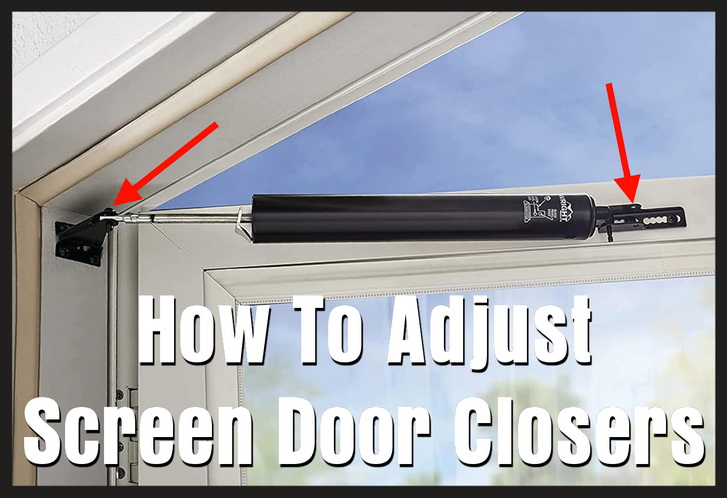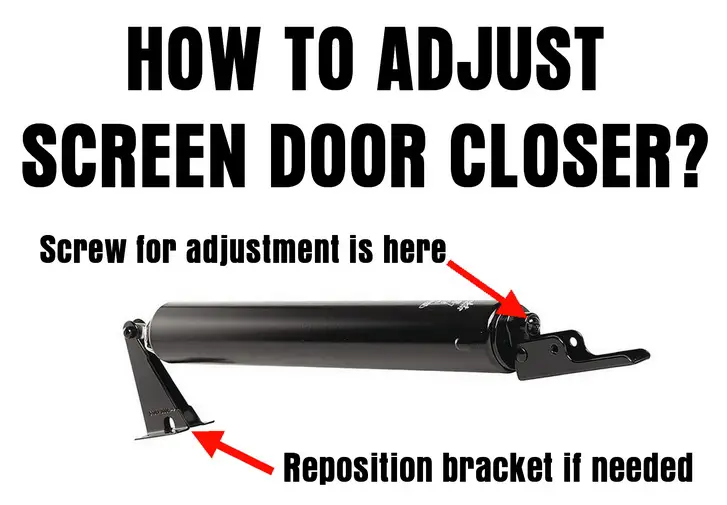Is your screen door not closing right? This guide will show you how to adjust, fix, or replace the closer on your pneumatic screen door. We’ll explain how these closers work, give you step-by-step instructions for making adjustments, and help you decide if it’s time for a replacement. Whether you’re dealing with a door that slams shut or one that won’t close properly, we’ve got you covered.

Pneumatic Screen Door Closers
A pneumatic screen door closer is a hydraulic device filled with air or gas, designed to control the speed at which your screen door closes. This prevents the door from slamming shut, reducing wear and tear on both the door and frame.
How It Works
The closer consists of a cylinder filled with air or a gas like nitrogen. When you open the door the cylinder compresses and builds up pressure. As you release the door, the pressure slowly releases controlling the door’s speed as it shuts.
Proper Adjustment Of Door Closer
Proper adjustment of the door closer is important. If the door closes too quickly, it can slam shut and damage the door or frame. If it closes too slowly, it may not shut completely and the door might be left open.
This video provides a visual explanation of how to adjust a pneumatic screen door closer.
Adjusting Your Screen Door Closer
Adjusting your screen door closer is simple, here’s how:
Option 1: Bracket Adjustment
If your door isn’t closing fully or properly aligning or adjusting the bracket can help. Reposition the arm on the bracket connected to the closer.
- Locate the Bracket: Find the bracket where the closer is attached to the door frame.
- Adjust the Arm: Loosen the screws on the bracket and move the arm to a different hole or position.
- Test the Door: After adjusting, open and close the door to test the new alignment. Repeat adjustments as necessary.
Option 2: Screw Adjustment
The closing speed is controlled by an adjustment screw located at the end of the pneumatic cylinder.
- Locate the Adjustment Screw: Find the screw at the end of the cylinder.
- Adjust the Screw:
- To slow down the closing, turn the screw clockwise.
- To speed up the closing, turn the screw counter-clockwise.
- Test and Readjust: Observe the closing speed and adjust as needed.

Here is a more detailed step by step guide with tools needed to adjust your screen door closer:
Tools You Might Need:
- Screwdriver
- Ladder or step stool for high-mounted closers
- Wrench (if the bracket needs adjustment)
Detailed Adjustment Guide:
- Identify the Adjustment Type: Determine whether you need to adjust the bracket or the screw.
- Make the Adjustments: Use the appropriate tools to adjust the bracket or screw.
- Test the Door: Open and close the door several times to test the new settings.
- Fine-Tune as Needed: If the door still doesn’t close correctly, repeat the adjustments.
- Check for Smooth Operation: Ensure the door closes smoothly without any jerking or resistance.
- Listen for Noises: Any unusual sounds could indicate a need for further adjustment or potential issues with the closer.
Fix Screen Door Closer Problems
Even with proper adjustment, screen door closers can develop issues. Here are some common problems and their solutions:
Door Slams Shut
If your screen door is slamming shut, it’s usually a sign that the closer is releasing pressure too quickly. This can be due to an adjustment issue or a malfunction within the closer itself.
Solution: Try adjusting the screw to slow down the closing speed. If this doesn’t work, the closer may need to be replaced.
Door Closes Too Slowly or Not at All
A door that closes too slowly or fails to latch might not be generating enough pressure in the closer.
Solution: Adjust the screw to increase the closing speed. If this fails, inspect the closer for leaks or damage.
Noisy Operation
A noisy closer may indicate a problem.
Solution: Lubricate the moving parts of the closer. If the noise persists, check for loose components or damage.
When to Replace Your Screen Door Closer
When adjusting your screen door closer isn’t enough a replacement might be necessary. What are the signs that you need a new closer? The door is slamming, it does not close, or you see visible damage to the closer.
This video guides you through the process of replacing a screen door closer, demonstrating the tools and techniques required.
Replacing Your Screen Door Closer
Replacing your screen door closer is an easy project. Here’s a detailed guide:
- Remove the Existing Closer: Carefully detach the closer from the door and frame.
- Select a Suitable Replacement: Ensure the new closer matches the type and size of the old one.
- Install the New Closer: Follow the instructions provided with the new closer.
Here is a more detailed step by step guide with the tools you will need to remove and replace your screen door closer:
Tools for Replacement:
- Screwdriver (Phillips or flat-head)
- Adjustable wrench or pliers
- New screen door closer
- Additional mounting hardware (if required)
Detailed Replacement Steps:
- Remove the Old Closer: Open the door, secure it, and remove the closer by detaching it from its mounting points.
- Prepare for the New Closer: Clean the mounting area and compare the new hardware with the old.
- Install the New Closer: Attach one end to the frame, extend the rod, and attach the other end to the door.
- Adjust the Tension: Fine-tune the closing speed using the adjustment screw.
- Final Checks: Ensure all components are secure and the door closes evenly.
If you need help with an existing door closer or need a new one, here are some links to better help you:
Williams screen door hardware
Anderson screen door closers
Screen door closers at Lowe’s
If you encounter issues with your screen door closer or need guidance on installation or repair, don’t hesitate to reach out for expert advice. Leave a comment below with your question, and we’ll be happy to assist you in ensuring your screen door functions.



Leave a Reply